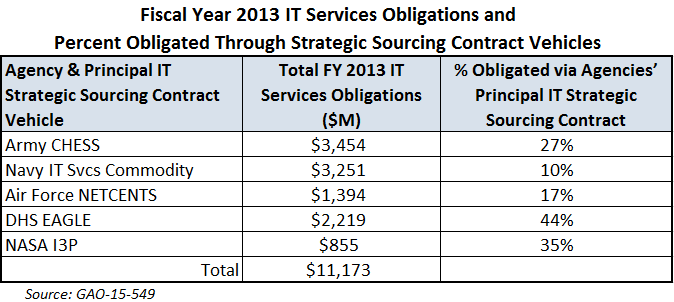Five Big Departments Struggle to Strategically Source IT Services
Published: December 01, 2015
Acquisition ReformUSAFARMYDHSIT ServicesNASANAVYStrategic Sourcing
Several large federal departments, including most of Departments of Defense (DOD), continue to struggle to run contracted IT services spending through their designated IT strategic sourcing contract vehicles, according to GAO.
In a recent report, GAO looked at the strategic sourcing IT spending for fiscal year (FY) 2013 at five large departments – the Army, Navy, Air Force, Department of Homeland Security (DHS), and the National Aeronautics and Space Administration (NASA) – to determine how well they were leveraging their buying power for high-spending areas such as IT services. The results revealed that most of these agencies diminished the government's buying power by continuing to obligate their IT services spending through hundreds of potentially duplicative contracts.
In fiscal year (FY) 2013, the Army, Navy, Air Force, DHS, and NASA collectively obligated more than $11 billion for IT services, but acquired only 10 to 44 percent of their respective IT services spending through strategic sourcing vehicles. (See table below.)

Observations
- The Army obligated 27 percent of its $3.4 billion on IT services spending through its CHESS strategic sourcing contacts. However, they also obligated about $1 billion on 437 standalone contracts.
- Navy’s IT Services Commodity Strategy requires buyers to use existing government-wide and enterprise-wide acquisition contracts for IT services, specifically GSA Alliant, Army ITES-2S, Air Force NETCENTS, National Institutes of Health government-wide acquisition contract for IT products, services, and solutions, the Navy’s SeaPort-e, and DISA’s ENCORE II. . The Navy’s percentage includes spending through these vehicles.
- DHS and NASA managed 44 and 35 percent, respectively, of their fiscal year 2013 obligations on IT services through their preferred strategic sourcing contract vehicles, more than the military departments. DHS noted that FY 2013 was a transition year between EAGLE I and EAGLE II which affected utilization so that spending was not fully representative.
- The Air Force indicated that FY 2013 was the transition year between NETCENTS I and II, which may have affected utilization. GAO found that more than 80 percent of the Air Force’s spending on IT services occurred outside of its NETCENTS contracts, including more than $400 million obligated through 295 standalone contracts.
Implications
GAO concluded that these federal agencies’ strategic sourcing efforts have not followed commercial best practices, such as establishing clearly defined roles and responsibilities for those responsible for strategic sourcing, conducting enterprise-wide spending analyses, effectively monitoring the spending going through the designated strategic sourcing vehicles, or establishing savings goals and metrics. Therefore, the agencies are not fully leveraging their buying power or maximizing their effectiveness at acquiring IT services.
In some cases, GAO found that standalone contracts at more than one agency were awarded to some of the same companies for some of the same services that are covered by their primary strategic sourcing vehicles. This raises costs on both agencies and contractors. Agencies miss opportunities for potential savings or to fully leverage their acquisition workforce and contractors must absorb increased proposal preparation costs and administrative expenses.